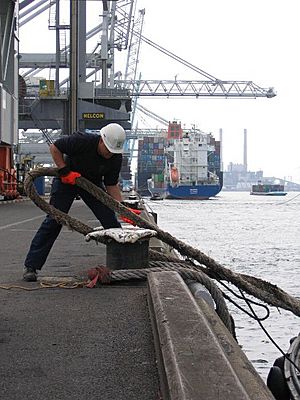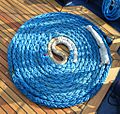Mooring facts for kids
A vessel (like a boat or ship) is moored when it is securely fastened to something. This could be a fixed object, like a dock or pier, or a floating object, like a special buoy with an anchor.
People usually moor a vessel using strong ropes called mooring lines or hawsers. These lines are attached to special hooks or posts on the vessel's deck at one end. The other end is fastened to fittings on the shore, such as thick posts called bollards, or metal rings and cleats.
Contents
What is Mooring?
Mooring is the way sailors and boaters keep their vessels in one place. It stops a boat from drifting away. Think of it like parking a car, but for a boat! It's super important for safety and to keep the vessel from hitting other things.
Why Do We Moor Vessels?
Vessels are moored for many reasons. They might be waiting to load or unload cargo, or for passengers to get on or off. Sometimes, boats are moored just to store them safely when they are not being used. It's also how ships stay put in harbors or marinas.
Types of Mooring
There are different ways to moor a vessel, depending on where it is and how long it needs to stay put.
Using Mooring Lines
This is the most common way to moor a vessel.
- Ropes and Cables: Thick ropes, often called mooring lines or hawsers, are used. For very large ships, strong steel cables might be used instead of ropes.
- Connecting to Shore: One end of the line is tied to the vessel. The other end is thrown to a dockworker or someone on shore. They then secure it to a bollard (a strong post), a ring, or a cleat (a T-shaped fitting).
- Adjusting the Lines: Sailors often use several lines to hold the vessel firmly. They can adjust the tightness of these lines to keep the boat stable, even when the tide changes or waves are present.
Mooring with a Permanent Anchor
Sometimes, vessels are moored using a permanent anchor that stays on the bottom of the water.
- Anchor System: A heavy anchor is placed on the seabed. A strong chain or cable, called a "rode," connects the anchor to a float on the surface of the water.
- Connecting to the Float: When a vessel wants to moor here, it connects its own line to this surface float. This way, the vessel is held in place by the permanent anchor without having to drop its own anchor. This is common in busy areas or places where anchors might damage the seabed.
Med Mooring
A special type of mooring, often used in the Mediterranean Sea, is called "Med mooring."
- Stern to Pier: In this method, the vessel backs up so its stern (the back of the boat) is very close to the pier.
- Anchors Forward: Two anchors are dropped from the front (bow) of the vessel. These anchors hold the bow away from the pier.
- Lines to Pier: Lines from the stern are then tied to the pier. This creates a secure "parking spot" where the vessel is held tightly from both ends.
Tools and Equipment
Many tools help with mooring.
- Bollards: These are strong, short posts on docks or piers where mooring lines are tied.
- Cleats: T-shaped fittings on both vessels and docks used to secure lines.
- Fenders: Soft bumpers placed along the side of the vessel to protect it from bumping into the dock or other boats.
- Heaving Line: A thin rope with a small weight at the end. It's thrown from the vessel to the shore to help pass the heavier mooring lines.
Images for kids
-
USS Orion (AS-18) "Med moored" with the stern tied to the pier and two anchors forward, in La Maddalena, Sardinia.
See also
In Spanish: Jarcia de amarre para niños







